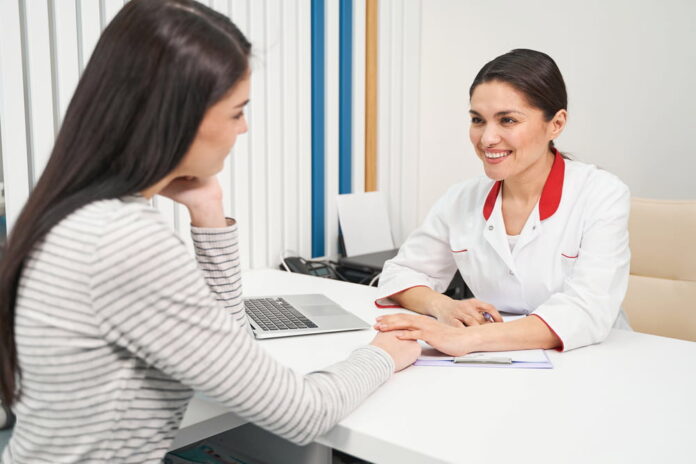It is true that most women are not aware of the peculiarities of fibroids and consider them normal. This can be very dangerous for their health, as you carry around with you some type of growth inside your body every day. That is why there are Questions to ask doctor to have every doubt cleared when dealing with fibroids – especially uterine fibroids.
Generally, these fibroids become evident during the menstrual cycle when they come out to light by showing symptoms like heavy or irregular periods, pelvic pain or pressure, and frequent urination.
Though the exact cause of uterine fibroids is unknown, several factors may contribute to their development. These factors include hormonal imbalances, genetics, and diet.
4 Vital Questions to Ask Your Uterine Fibroid Doctor
Here are four vital questions that you must ask your doctor:
Q1: Are Uterine Fibroids Cancerous?
No, uterine fibroids are not cancerous. They are benign (non-cancerous) tumors that grow in the uterus. Uterine fibroids are very common and are estimated to occur in up to 70-80% of women at some point in their lives.
While uterine fibroids are not cancerous, they can cause a variety of symptoms. If you have been diagnosed with uterine fibroids and are concerned about cancer, it is important to speak with your healthcare provider.
Q2: Do Uterine Fibroids Cause Infertility?
Uterine fibroids can potentially cause infertility, although this is not common. It’s not uncommon for women with uterine fibroids to experience pelvic pain and heavy menstrual bleeding. In some cases, these symptoms may be severe enough to interfere with your ability to conceive a child or carry one to term.
Uterine fibroids can cause fertility problems if they grow large enough to block the passage of an egg through the fallopian tube or if they interfere with the implantation of a fertilized egg in the uterine lining.
While these conditions are typically treated with medication, they also need to be monitored by your doctor on an ongoing basis so that he can identify any changes in your health status and adjust treatment accordingly if needed.
Q3: Are there Non-surgical Treatment Options available?
Yes, there are several non-surgical treatment options available for uterine fibroids. The most appropriate treatment option for you will depend on the size and location of your fibroids, your symptoms, and your overall health.
In addition, some women prefer non-surgical methods of treating uterine fibroids because they don’t require anesthesia and may be less invasive than surgery. Some non-surgical treatment options for uterine fibroids include medications that include hormone therapy, Uterine artery embolization (UAE), Magnetic resonance-guided focused ultrasound (MRgFUS), and Myomectomy.
Q4: What’s the Best Way to Track Fibroid Growth?
It’s essential to track your weight, blood pressure, menstrual cycle, and BMI (body mass index) to monitor your fibroid growth. The best way to do this is by using a reliable scale and taking measurements at regular intervals during the day or week.
There are several ways to track the growth of uterine fibroids. The most common method is through pelvic exams and imaging tests.
Conclusion
Among the top Questions to ask doctor, remember to ask whether peeing frequently or seeing a bulge in the stomach are signs of fibroid growth.
Fibroids are common in women, and about 2% of all pregnancies end in miscarriage due to their presence. If you have trouble getting pregnant due to your uterus being full of these benign tumors, then surgery might be necessary to remove them from your body.
Read Also
- Ketamine-Assisted Therapies: Impacts on Employee WellbeingWorkplace stress is common today. Many employees feel tired, anxious, or burned out. Regular therapy can help, but some people need more support. Ketamine-assisted therapy is showing good results for mental health. A ketamine-assisted therapist guides each session safely. This therapy can improve mood, focus, and energy. Learning more about it can help teams stay… Read more: Ketamine-Assisted Therapies: Impacts on Employee Wellbeing
- The Future of Men’s Health: Why Telehealth Is Here to StayTelehealth isn’t just a pandemic trend that faded into the background. For Australian men, it has become one of the most practical, time-saving, and stress-free ways to manage everyday health — and it’s shaping the future of how we access care. Platforms like DOCTO, an Australian online doctor and specialist telehealth service, are leading the… Read more: The Future of Men’s Health: Why Telehealth Is Here to Stay
- How to Build a Simple, Clean Skincare Routine ?You don’t need a complicated skincare routine. It doesn’t have to be something that requires twenty different products and confusing steps. Your routine works well with just a few high-quality clean ingredients. The beauty industry keeps pushing more products, but your skin actually needs less. You only need a simple approach to get better results… Read more: How to Build a Simple, Clean Skincare Routine ?
- How Preventive Dental Care Supports Overall HealthHave you ever wondered how a simple dental checkup could impact your entire body? Oral health is more than just a bright smile. Studies show that poor dental habits can contribute to serious health problems. Gum disease and tooth decay are linked to heart disease, diabetes, and infections. Yet, many people overlook preventive dental care.… Read more: How Preventive Dental Care Supports Overall Health
- Seeing Clearly in a High-Tech World: A Deep Dive into Advanced Vision Care ServicesProtecting your eyesight isn’t optional—it’s essential. Modern eye care has evolved far beyond basic exams, offering advanced diagnostics, personalized treatments, and surgical innovations that keep vision sharp for life. A leading example is Intermountain Eye Center, home to specialists like Dr Fishburn Boise, where patients receive comprehensive, high-level vision care designed to preserve long-term eye… Read more: Seeing Clearly in a High-Tech World: A Deep Dive into Advanced Vision Care Services






